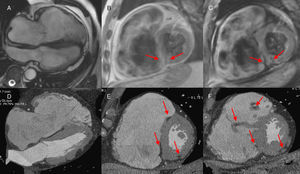Arrhythmogenic right ventricular dysplasia (ARVD) is diagnosed using established criteria, and those based on imaging data are of essential importance. Magnetic resonance imaging was performed in a 63-year-old male smoker with hypertension and dilated cardiomyopathy. The study showed dilation of the right ventricle (RV) (Figure 1A), with severe dysfunction, areas of wall akinesia, and aneurysms. Left ventricular function was depressed (52%). Double inversion-recovery sequences detected hyperintense areas in the left ventricle and interventricular septum (Figure 1B, arrows), which were hypointense on fat-suppressed sequences (Figure 1C, arrows), indicating foci of intramyocardial fat infiltration. We diagnosed ARVD as the cause of ventricular dysfunction (3 major criteria of Mckenna were met: 2 imaging criteria and the epsilon wave). Multidetector computed tomography excluded coronary disease and showed similar RV morphologic abnormalities (Figure 1D) and intramyocardial hypodensities, consistent with fat infiltration affecting both ventricles (Figure 1E and F).
Figure 1.
Magnetic resonance imaging is currently the technique of choice for diagnosing ARVD. The excellent spatial and temporal resolution of this technique enables detection of morphologic abnormalities and fat infiltration, which is of interest (although not a diagnostic criterion) in assessing for ARVD. Multidetector computed tomography is also a valid technique for this purpose because its high spatial resolution enables clear depiction of fat infiltration.
Because of the lack of studies comparing these imaging methods in the diagnosis of ARVD and the fact that multidetector computed tomography involves radiation exposure, the use of this technique would be justified in patients with a defibrillator and those with arrhythmia or claustrophobia.
Corresponding author: eduzatanico@hotmail.com


